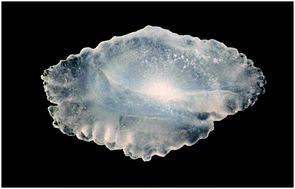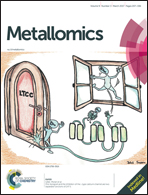Trace element–protein interactions in endolymph from the inner ear of fish: implications for environmental reconstructions using fish otolith chemistry†
Abstract
Otoliths, the biomineralised hearing “ear stones” from the inner ear of fish, grow throughout the lifespan of an individual, with deposition of alternating calciferous and proteinaceous bands occurring daily. Trace element : calcium ratios within daily increments measured by laser ablation-inductively coupled plasma-mass spectrometry (LA-ICP-MS) are often used in fisheries science to reconstruct environmental histories. There is, however, considerable uncertainty as to which elements are interacting with either the proteinaceous or calciferous zones of the otolith, and thus their utility as indicators of environmental change. To answer this, we used size exclusion chromatography-inductively coupled plasma-mass spectrometry (SEC-ICP-MS) of endolymph, the otolith growth medium, to determine the binding interactions for a range of elements. In addition, we used solution ICP-MS to quantify element concentrations in paired otolith and endolymph samples and determined relative enrichment factors for each. We found 12 elements that are present only in the proteinaceous fraction, 6 that are present only in the salt fraction, and 4 that are present in both. These findings have important implications for the reconstruction of environmental histories based on changes in otolith elemental composition: (1) elements occurring only in the salt fraction are most likely to reflect changes in the physico-chemical environment experienced during life; (2) elements occurring only in the proteinaceous fraction are more likely to reflect physiological rather than environmental events; and (3) elements occurring in both the salt and proteinaceous fractions are likely to be informative about both endogenous and exogenous processes, potentially reducing their utility in environmental reconstructions.

- This article is part of the themed collection: Metals in marine biochemistry


 Please wait while we load your content...
Please wait while we load your content...